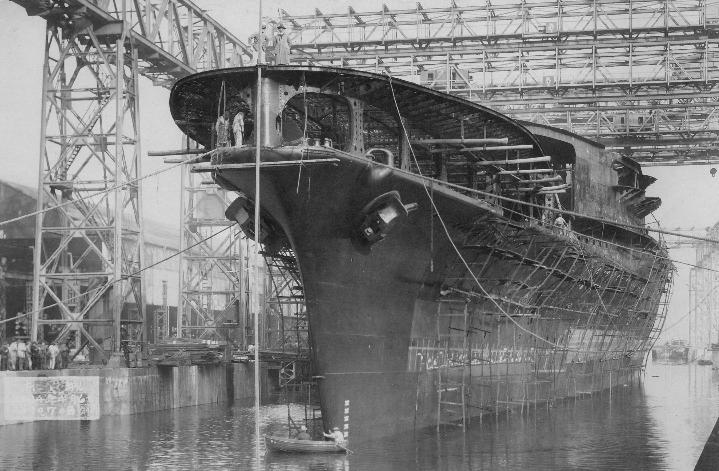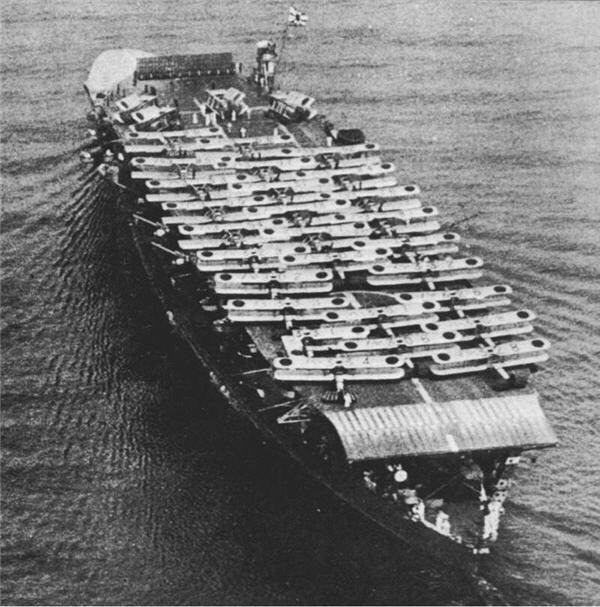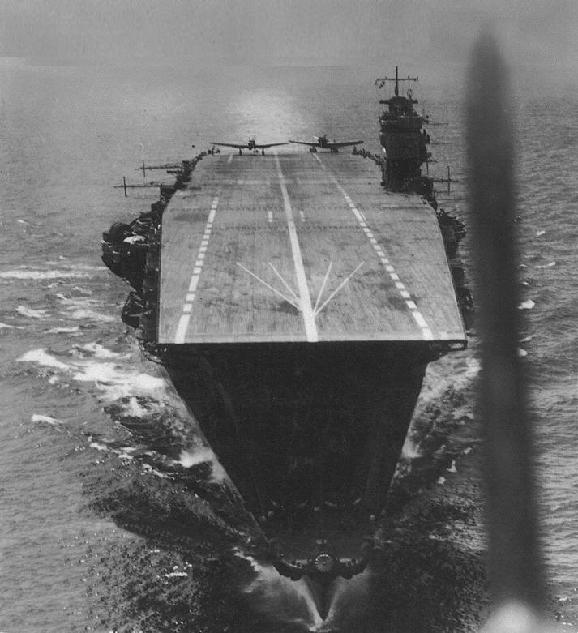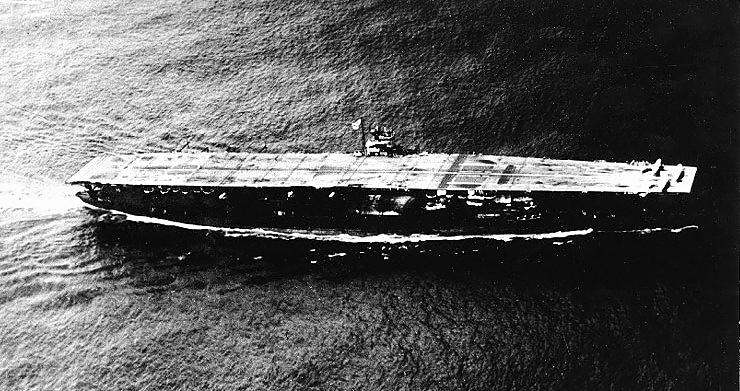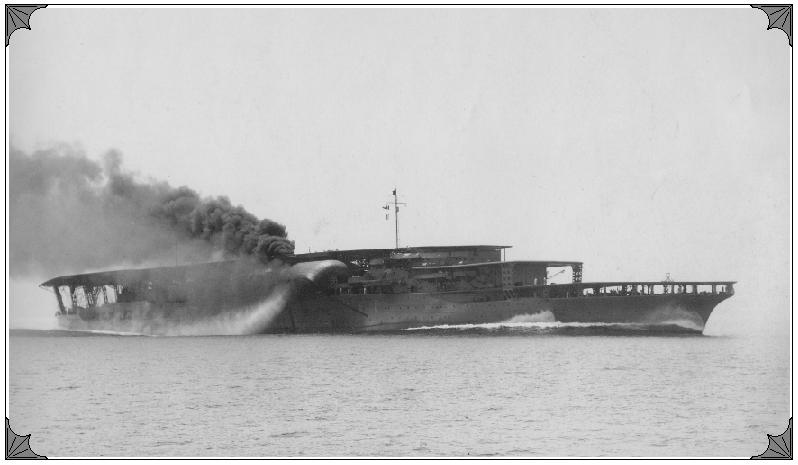
Imperial Japanese Navy - AKAGI Aircraft Carrier ==========================================================================

Akagi ("red castle") was an aircraft carrier of the Imperial Japanese Navy, originally begun as an Amagi-class battlecruiser. She participated in the Second Sino-Japanese War in the late 1930s. She took part in the Pearl Harbor raid, several battles in the Southwest Pacific in January and February 1942, the Indian Ocean raid, and her flight deck, destroyed and ravaged by unstoppable fires, was damaged severely enough during the Battle of Midway on 4 June 1942 that she had to be sunk by the Japanese themselves the following day. Captain Taijiro Aoki attempted to go down with his ship until being forcibly removed by his crew.
The Akagi was designed as a battlecruiser, much like her American Lexington-class contemporaries. She was converted into an aircraft carrier under the auspices of the 1922 Washington Naval Treaty. Based on a battlecruiser, Akagi was a unique looking aircraft carrier. At the time of her construction, there were not many aircraft carriers in the navies around the world, hence there were no "standard design" at this early stage, which resulted in her unique configuration: triple-flight deck, unconventional port-side island, and six 8-in guns.
Since Akagi was initially conceived as a battlecruiser, the prevailing ship naming conventions dictated that she (like her sister battleships) be named after a mountain. Akagi was named after Mount Akagi, a dormant volcano in the Kanto region (the name literally means "red castle"). After she was redesignated as an aircraft carrier her mountain name remained, in contrast to dedicated aircraft carriers like Soryu, which were named after flying creatures. The Akagi name was previously given to the Maya class gunboat Akagi.
Akagi was supposed to have a sister ship, Amagi. The Amagi project was abandoned after her under-construction hull was damaged beyond repair during the Great Kanto Earthquake of 1923.
Akagi was originally laid down as a 41,200 ton Amagi-class battlecruiser at Kure, Japan. However, the Washington Naval Treaty, which Japan signed in 1922, prevented Japan from completing Akagi. Because the Treaty authorized conversion of two battleship or battlecruiser hulls into aircraft carriers of up to 33,000 tons displacement, the incomplete hulls of Amagi and Akagi were selected for completion as carriers. However Amagi's hull was damaged beyond economic repair in the Great Kanto earthquake of 1 September 1923. A year later the decision was made to convert the Akagi into the largest air craft carrier of the Imperial Navy. A sister ship, the Kaga, also laid down as a battle cruiser, commenced conversion to a carrier at approximately the same time. Akagi, the only remaining member of her class, was launched on 22 April 1925 and commissioned at Kure Naval Arsenal on 25 March 1927, although trials continued through November 1927.
The Akagi replaced the Hosho as the largest operational aircraft carrier in the Imperial Navy. A year later, she was joined by the Kaga. The Akagi remained the flagship of the carrier force and performed in this role for the force that attacked the United States naval base of Pearl Harbor on 7 December 1941.
Akagi, like Kaga, was completed with three superimposed flight decks, the only carriers ever to be designed so. The British carriers converted from "large light cruisers", HMS Glorious, HMS Courageous, and HMS Furious each had two flight decks, but there is no evidence that the Japanese copied the British model. It is more likely that it was a case of convergent evolution as a means to launch as many aircraft as quickly as possible. Akagi's main flight deck was 190.2 metres (624 ft) long, her middle flight deck began right in front of the bridge and was only 15 metres (49 ft) long and her lower flight deck was 55.02 metres (180.5 ft) long. The utility of her middle flight deck had to be questionable as it was so short that only lightly loaded aircraft had any chance of using it at all, even in an era where the aircraft were much lighter and smaller than they were during the Second World War. At any rate the ever-increasing growth in aircraft performance, size and weight meant that even the bottom flight deck was no longer able to accommodate the take-off roll required for the new generations of aircraft being fielded and it was plated over when the ship was modernized in the mid-1930s.
As completed, the ship had two main hangar decks and a third auxiliary hangar with a total capacity of 60 aircraft. The hangars opened onto the middle and lower flight decks to allow aircraft to take off directly from the hangars, while landing operations were in progress on the main flight deck above. No catapults were fitted. Her forward aircraft lift was offset to starboard and 11.8 by 13 metres (39 ft × 43 ft) in size. Her aft lift was on the centerline and 12.8 by 8.4 metres (42 ft × 28 ft). Her arresting gear was an unsatisfactory British longitudinal system used on their aircraft carrier Furious that relied on friction between the arrester hook and the cables. The Japanese were well aware of this system's flaws, as it was already in use on Hosho, but had no other alternatives available when Akagi was completed. It was replaced with a transverse cable system developed by Shiro Kabaya when she was refitted in 1931 and that was replaced in turn by the Kure Model 4 type (Kure shiki 4 gata) before Akagi began her modernization in 1935. No island was fitted as completed, the ship being commanded from a space below the forward end of the upper flight deck.
Akagi was armed with ten 20 cm (7.9 in)/50 3rd Year Type No. 1 guns; one twin Model B turret on each side of the middle flight deck and six in Model A1casemates aft. They fired 110-kilogram (240 lb) projectiles at a rate of 3–6 rounds per minute with a muzzle velocity of 870 m/s (2,900 ft/s); at 25°, this provided a maximum range between 22,600–24,000 m (24,700–26,200 yd). The Model B turrets were nominally capable of 70° elevation to provide additional anti-aircraft fire, but in practice the maximum elevation was only 55°. The slow rate of fire and the fixed 5° loading angle minimized any real anti-aircraft capability. This heavy gun armament was provided in case she was surprised by enemy cruisers and forced to give battle. While superficially logical this ignored her large and vulnerable flight deck, hangars, etc., that made her more of a target in any surface action than a fighting warship. The Americans did much the same with the provision of four twin 8-inch (203 mm) gun turrets on their Lexington-class carriers. She was given an anti-aircraft armament of six twin 12 cm (4.7 in) 45-caliber 10th Year Type Model A2 gun mounts fitted on sponsons below the level of the funnels, where they could not fire across the flight deck, three mounts per side. These guns fired 20.3-kilogram (45 lb) projectiles at a muzzle velocity of 825–830 m/s (2,710–2,720 ft/s); at 45° this provided a maximum range of 16,000 m (17,000 yd), and they had a maximum ceiling of 10,000 m (11,000 yd) at 75° elevation. Their effective rate of fire was 6–8 rounds per minute.
Akagi's waterline armored belt was reduced from 254 to 152 mm (10.0 to 6.0 in) and the upper part of her torpedo bulge was given 102 mm (4.0 in) of armor. Her deck armor was also reduced from 96 to 79 mm (3.8 to 3.1 in).
When Akagi was being designed the problem of how to deal with exhaust gases in carrier operations had not been resolved. The swivelling funnels of the Hosho had not proved successful and wind-tunnel testing had not provided an answer either. So Akagi and Kaga were each given different solutions to evaluate in real-world conditions. Akagi was given two funnels on the starboard side. The larger, forward funnel was downturned 120° with its mouth facing the sea and the smaller one exhausted vertically a little past the edge of the flight deck. The forward funnel was fitted with a water-cooling system to reduce the turbulence caused by hot exhaust gases and a blind cover designed to allow the exhaust gases to escape if the ship developed a severe list and the mouth of the funnel touched the sea.
Akagi was completed with her original four Gihon geared steam turbines with a total of 131,000 shp (98,000 kW) on four shafts. As a battlecruiser her expected speed was 28.5 knots (32.8 mph; 52.8 km/h), but the reduction in weight from 41,200 to 34,000 long tons (41,900 to 34,500 t) allowed to her speed to increase to 32.5 knots (37.4 mph; 60.2 km/h) on trials on 17 June 1927. She had nineteen Type B Kampon boilers with a working pressure of 20 kg/cm2 (1,961 kPa; 284 psi), some of which were oil-fired and the others used a mix of oil and coal. She carried 3,900 long tons (4,000 t) of fuel oil and 2,100 long tons (2,100 t) of coal to give her a range of 8,000 nmi (14,820 km) at 14 knots (26 km/h).
Akagi's early career was uneventful, consisting of various training exercises. She was reduced to second class reserve status on 1 December 1931 in preparation for a short refit where her arresting gear was replaced and her radio and ventilation systems overhauled and improved. She became a first class reserve ship again exactly a year later, but it was not until 25 April 1933 that she resumed active service and joined the 2nd Carrier Division and participated in that year's Special Fleet Maneuvers. She remained on active duty until 15 November 1935 when she was reduced to third-class reserve in preparation for her modernization at Sasebo Naval Arsenal.
Already being the most expensive ship in the Japanese fleet, she underwent an expensive refitting in 1935 that gave her the full-length flight deck configuration that she would enter the Pacific War with. The American pilots identified her as a carrier with a boxy superstructure and an improbably high flight deck that towered six-stories above the main deck.
Although Akagi's modernization was to take nearly three times as long as that of Kaga, far less work was involved. The three flight decks had shown their lack of ability to handle ever larger and heavier aircraft and Akagi's flight deck and hangars were extended to the bow, increasing the flight deck length to 249.17 metres (817.5 ft) and raising aircraft capacity to 86 (61 operational and 25 in storage). A third elevator midships, 11.8 by 13 metres (39 ft × 43 ft) in size, was added. Her arrester gear was replaced by a Japanese-designed Type 1 system. The modernization added an island superstructure on the port side of the ship, which was an unusual arrangement; the only other carrier to share this feature was a contemporary, the Hiryu. Akagi and Hiryu were intended to work in a tactical formation with starboard-sided carriers, in order to improve the flight pattern around the formation, (and possibly to improve mutual visibility of signal flags flown from each bridge when operating under radio silence, assuming the carrier with the port side bridge is to the starboard of the other carrier) but the experiment was not continued beyond those two carriers. Strategists planned to use these carriers in a formation that was unique. The lead carriers in the basic formation were to be the port-islanded Hiryu and Akagi, followed by the Soryu and Kaga. This supposedly allowed for a more compact formation with nonconflicting aircraft traffic patterns. This formation was later used in the Battle of Midway.
A significant addition was a four foot wide bulge to the hull of the ship on both sides of the Akagi, which provided better protection under the waterline, as well as offered improved stability. Lastly, a third airplane lift was added to the pre-existing two lifts. Overall, the Akagi became a showpiece in the fleet for innovative technologies which later were deemed at best impractical and at worse terrible, with the result that they were never adopted by other carrier manufacturers.
Akagi's speed was already satisfactory and the only changes to her machinery were the replacement of the mixed coal/oil-fired boilers with modern oil-fired units and the improvement of the ventilation arrangements. Her speed declined slightly because of the increase in her displacement to 41,300 long tons (42,000 t) from 32.5 to 31.2 knots (37.4 to 35.9 mph; 60.2 to 57.8 km/h) on trials. Her bunkerage was increased to 7,500 long tons (7,600 t) of fuel oil which increased her endurance to 10,000 nmi (18,520 km) at 16 knots (30 km/h). The rear vertical funnel was changed to match the forward funnel and incorporated into the same casing.
The two twin turrets on the middle flight deck were removed and fourteen twin 25 mm (0.98 in) Type 96 gun mounts were added on sponsons. They fired .25-kilogram (0.55 lb) projectiles at a muzzle velocity of 900 m/s (3,000 ft/s); at 50°, this provided a maximum range of 7,500 m (8,200 yd), and an effective ceiling of 5,500 m (6,000 yd). The maximum effective rate of fire was only between 110–120 rounds per minute due to the frequent need to change the 15-round magazines. Six Type 95 directors were fitted to control the new 25 mm guns and two new Type 94 anti-aircraft directors replaced the outdated Type 91s. After the modernization Akagi carried one Type 89 director for the 20 cm (7.9 in) guns; it is uncertain how many were carried before then.
After the 1935 refitting Akagi became the first Japanese carrier with a modern large flight deck, and it was the operational experiences aboard the Akagi that forged the Japanese naval airpower doctrine. She participated in every major action in the early part of the war, including Pearl Harbor, the attack against Port Darwin, operations in the Indian Ocean, and the Battle of Midway. Unfortunately, with her unique design came an unique weakness as well, and the weakness presented itself during the Battle of Midway. Aside from the fact that her anti-aircraft weaponry were of an older and slow-firing design, they were also positioned poorly. Her anti-aircraft batteries were positioned on the port and starboard sides of the ship, twenty or so feet below the flight deck, therefore guns on each side could only fire at targets on the same side of the ship. Additionally, port side guns are additionally blocked by the island, further reducing the effectiveness of the weapons. This was one of the many reasons why she was fatally attacked at Midway on 4 Jun 1942 at the hands of American dive bombers.
Ironically, as soon as Akagi was to have returned from Midway her 12 cm (4.7 in) 45-caliber 10th Year Type guns were scheduled to be replaced by more modern 12.7 cm (5.0 in)/40 Type 89 gun mounts. And their sponsons were to be raised one deck to allow them some measure of cross-deck fire as was done during Kaga's modernization.
She was reclassified as a special purpose ship (Tokubetse Ilomokan) on 15 November 1940 while she was being overhauled. She joined the First Carrier Division (Akagi and Kaga) as flagship on 10 April 1941 when the Imperial Navy combined the First Carrier Division, the Second Carrier Division (Hiryu and Soryu), and Fifth Carrier Division (Shokaku and Zuikaku) into the First Air Fleet or Kido Butai (Striking Force).
In World War II, under the command of Captain Kiichi Hasegawa, she was Vice Admiral Chuichi Nagumo's flagship for the Striking Force for the attack on Pearl Harbor in December 1941. She launched two waves of planes at Oahu. In the first wave 27 "Kates" torpedoed the battleships Oklahoma and West Virginia and 9 "Zeros" attacked the air base at Hickam Field. In the second wave, 18 "Vals" targeted the battleship Maryland, the light cruiser Raleigh and the destroyer Shaw while 9 "Zeros" attacked various American airfields.
She sortied, along with Kaga and the carrier Zuikaku against American forces attacking the Marshall Islands on 1 February 1942 before being recalled. On 7 February she, with the other carriers of the First and Second Carrier Divisions, was ordered south to the Timor Sea, where on 19 February 1942 she launched air strikes against Darwin, Australia. Akagi contributed 18 "Kates", 18 "Vals", and 9 "Zeros" to the attack which caught the defenders by surprise. Eight ships were sunk, including the American destroyer Peary, and fourteen more were damaged. On 1 March the American oiler Pecos was sunk by "Vals" from Soryu and Akagi. Later that same day the American destroyer Edsall was attacked and sunk by "Vals" from Akagi and Soryu in combination with gunfire from two battleships and two heavy cruisers of the escort force. Akagi and her consorts covered the invasion of Java although her main contribution appears to have been providing 18 "Kates" and 9 "Zeros" for the 5 March 1942 air strike on Tjilatjap. This was very successful, sinking eight ships in the harbor there and none of Akagi's aircraft were lost. On 26 March Akagi set sail for the Indian Ocean raid.
On 19 April 1942 she took part in the unsuccessful pursuit of the American carriers Hornet and Enterprise after they launched the Doolittle Raid and dropped anchor in Yokosuka on 22 April.
On 25 May 1942 the Akagi set out with the Striking Force for the attack on Midway Island. Her aircraft complement consisted of 24 Mitsubishi A6M "Zero" fighters, 18 Aichi D3A "Val" dive bombers, and 18 Nakajima B5N "Kate" torpedo bombers. At dawn on 4 June she launched an air strike against the airfield on Eastern Island that consisted of eighteen "Vals" escorted by nine "Zeros". The only casualty was one "Zero" shot-down by AA fire, but three others were damaged; four "Vals" had been damaged as well, although only one was non-repairable. One "Kate" was also launched to help search for the Americans. She also put up three "Zeros" on combat air patrol.. Another six "Zeros" had reinforced her CAP by 07:00 and all nine fighters helped to defend the Kido Butai from the first attackers from Midway Island at 0710. Akagi was attacked by four torpedo-carrying Martin B-26 Marauders, all of which missed, but one shot down one of her Zeros while another strafed Akagi after dropping her torpedo, killing two men. Another narrowly missed hitting the bridge before cartwheeling into the sea. At 07:15 Admiral Nagumo ordered the "Kates" still on Kaga and Akagi rearmed with bombs for another attack on Midway itself. This process was limited by the number of ordnance carts used to handle the bombs and torpedoes and the limited number of ordnance elevators. This meant that the torpedoes could not be struck below until after all the bombs were moved up from their magazine, assembled and mounted on the aircraft. This process normally took about an hour and a half; more time would be required to bring the aircraft up to the flight deck, warm up and launch the strike group. Around 07:40 he reversed his order when he received the message that the Americans had been spotted.
Akagi's three remaining CAP fighters were among those that attacked sixteen Marine SBD Dauntless dive-bombers of VMSB-241 which fruitlessly attacked Hiryu around 07:55. At roughly the same time she was attacked by four B-17 Flying Fortress aircraft bombing from 20,000 feet (6,100 m). This gave the Japanese captains enough time to anticipate where the bombs would land and successfully maneuver their ships out of the impact area. Akagi replenished the CAP with launches of three "Zeros" each at 08:08 and 08:32. Akagi began landing her strike force aboard immediately afterwards and was finished shortly after 09:00. Six of Akagi's "Zeros" were still in the air when the CAP intercepted the TBD Devastator torpedo-bombers of VT-8 at 09:22 and shot down all fifteen, leaving only a single survivor treading water. Shortly afterwards fourteen Devastators from VT-6 were spotted. They tried to sandwich Kaga, but the CAP, reinforced by an additional nine "Zeros" launched by Akagi at 09:33 and 09:40, shot down all but four of the Devastators.
At approximately 10:26, three SBD Dauntless dive-bombers from Enterprise's VB-6 attacked. Akagi took two bomb hits, tearing into below decks. The most damaging hit on Akagi came in the form of a near miss by Ensign Frederick Thomas Weber, which damaged the ship's port rudder, rendering her essentially unnavigable. The fatal shot was scored by American pilot Lieutenant Richard Best whose bomb landed at the aft edge of the middle elevator. "Nobody pushed his dive steeper or held it longer than Dick," commented Best's backseater James Murray. Best's 1,000-lb bomb crashed through the flight deck and exploded in the upper hangar, instantly killing many Japanese crewmen working in the enclosed hangar and hurling everything from men to aircrafts over the edge of the flight deck. This hit set off explosions among the eighteen fully armed and fueled "Kates" that were being prepared for an air strike against the American carriers. The burning aviation fuel proved impossible to control and the rear near-miss caused the port rudder to jam off-center after an evasive maneuver 20 minutes later.
Initially refusing to leave the ship, Admiral Chuichi Nagumo, in operational command, was finally convinced by Captain Taijiro Aoki to transfer his flag to another ship after explaining to the admiral that commanding a fleet would be impossible on a burning ship - especially without a working radio; they transferred his flag to the light cruiser Nagara at 10:46.
Her engine somehow came back to life at 1203, but it was somewhat useless as she could only sail in circles to starboard due to rudder damage. At 1338, the Emperor's portrait was removed in preparation for abandoning ship. Akagi stopped dead in the water at 13:50 and her crew, except for Captain Taijiro Aoki and damage-control personnel, was evacuated.
The damage-control teams were eventually evacuated as well, as was (under duress) Aoki. When Captain Taijiro Aoki abandoned the ship (he was the last to leave her), she had already been burning for nearly nine hours. She burned through the night but did not sink.
Her hull remained afloat until 0200 the next morning when Yamamoto ordered her scuttled by torpedoes from the destroyers Arashi, Hagikaze, Maikaze, and Nowaki. She sank at 05:20 with the loss of 267 men. Akagi was the first Japanese capital ship in WW2 to be scuttled by her own fellow ships in the Pacific. As she went down, survivors shouted "Banzai! Akagi banzai!" from the safety of the destroyers. Compared to the other Japanese fleet carriers lost in the battle, she was the luckiest, suffering the fewest casualties.
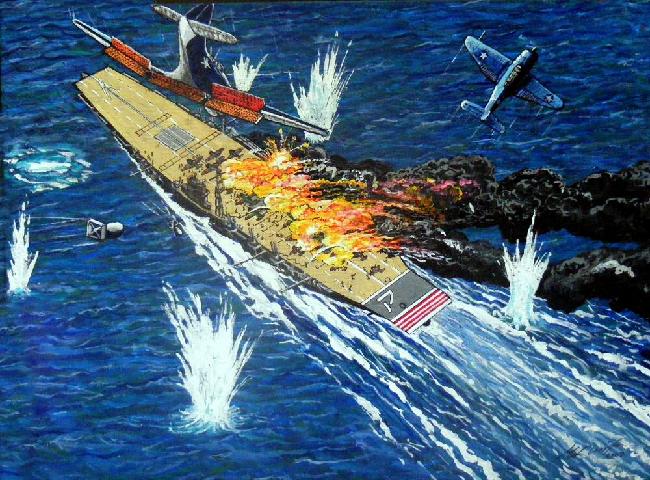
=================================================================================
NB: The above text has been collected / excerpted / edited / mangled / tangled / re-compiled / etc ... from the following online sources :
Aircraft Carrier Akagi - wikipedia article
Akagi Aircraft Carrier - www.globalsecurity.org
Carrier Akagi - ww2db.com

